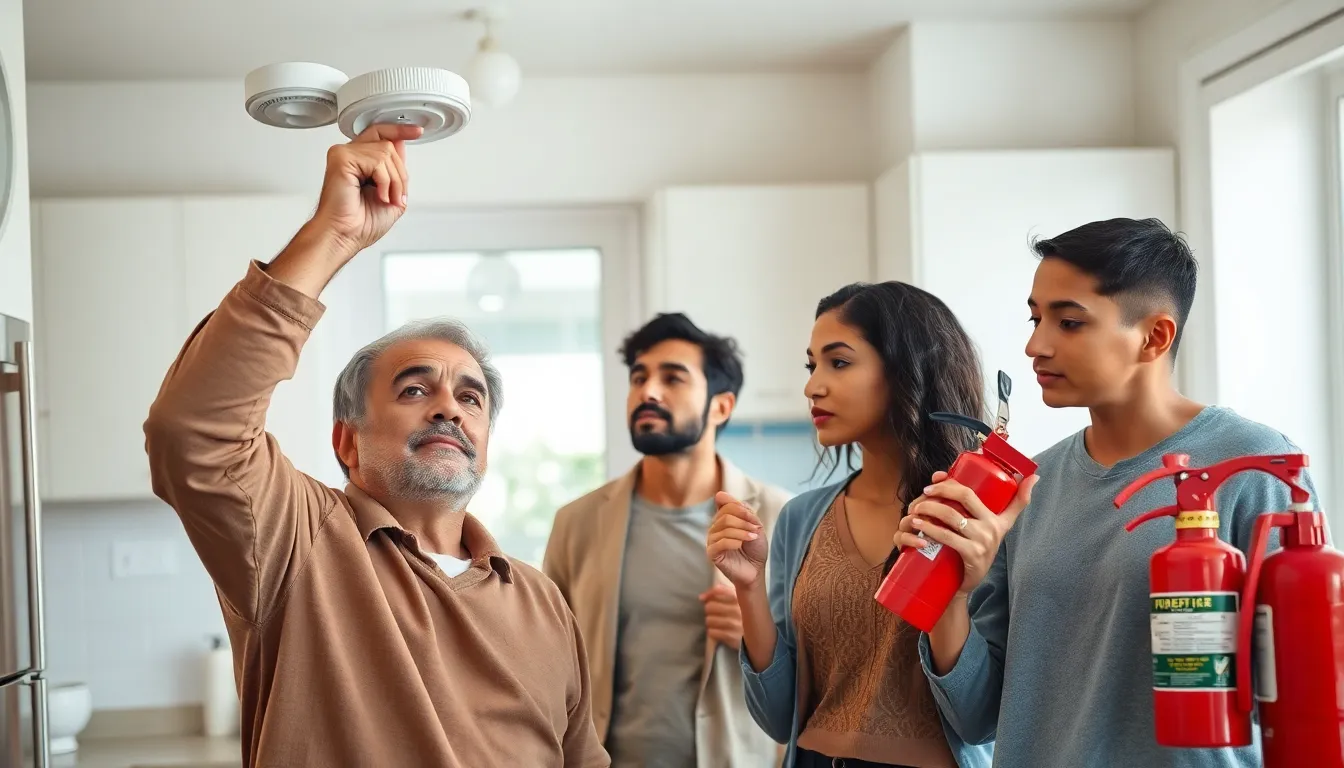When it comes to living in a rental, fire safety might not be the first thing on anyone’s mind. After all, who wants to think about flames when there’s a perfectly good pizza in the oven? But ignoring fire safety can turn a cozy night in into a fiery fiasco faster than you can say “smoke alarm.”
Table of Contents
ToggleUnderstanding Fire Safety In Rentals
Fire safety in rental properties requires attention from both tenants and landlords. Awareness of potential hazards and implementing preventive measures can save lives and property.
Importance Of Fire Safety
Effective fire safety reduces the risk of injuries, fatalities, and extensive property damage. Each year, thousands of fires occur in rental units due to negligence, often caused by simple oversights. Tenants must understand their responsibilities, including checking smoke detectors and knowing escape routes. Landlords should provide maintenance and ensure safety measures are in place, such as accessible fire extinguishers and clear fire exit pathways. Regular inspections can reinforce safety standards and educate residents about the importance of vigilance.
Common Fire Hazards In Rental Properties
Several fire hazards frequently appear in rental properties. Cooking equipment such as stoves and ovens often lead to fires when left unattended. Electrical malfunctions, including overloaded outlets and faulty wiring, pose significant risks as well. Improperly stored flammable materials, like cleaning supplies or paper products, can ignite easily. Using space heaters without ample clearance can also be dangerous, especially in small rooms. Each of these hazards demands attention and preventive action to promote a safer living environment.
Legal Requirements For Fire Safety
Fire safety laws exist to ensure safe living environments in rental properties. Compliance with these regulations protects both tenants and landlords from potential hazards.
Local Fire Codes And Regulations
Local fire codes vary by state and municipality. Each area has specific rules governing the installation of smoke detectors, fire alarms, and sprinkler systems. Most jurisdictions require smoke detectors in every rental unit. These devices must be functional and tested regularly. In some locations, landlords must provide fire extinguishers in accessible areas. Tenants should familiarize themselves with the local codes to understand their rights and responsibilities. Reporting any deficiencies in fire safety equipment to property owners is essential for maintaining compliance with regulations.
Responsibilities Of Landlords And Tenants
Landlords play a crucial role in ensuring fire safety within rental properties. They must maintain equipment like smoke detectors and fire extinguishers. Regular inspections of these systems promote safety awareness. Tenants also share responsibility for fire safety. They need to keep exit pathways clear and practice fire drills. Properly storing flammable materials reduces fire risks. Communication between tenants and landlords regarding fire safety concerns strengthens safety measures. Both parties must prioritize safety to prevent fires and protect lives.
Fire Safety Equipment
Fire safety equipment plays a crucial role in protecting residents from fire hazards. Proper installation and maintenance of these devices significantly reduce the risk of injuries and property damage.
Smoke Detectors
Smoke detectors should be installed in every rental unit and checked regularly. Tenants need to test these alarms monthly to ensure they function correctly. Installing battery-operated models in sleeping areas enhances safety. When smoke is detected, alarms should sound loudly enough to wake those who are asleep. Replacement of batteries occurs semi-annually or immediately if the alarm chirps. Landlords should ensure that all detectors meet local fire codes and replace outdated models.
Fire Extinguishers
Accessible fire extinguishers must be available in rental properties, especially in kitchens and near exits. Fire extinguishers should have a minimum rating of 2A:10B:C for common residential hazards. Regular inspections confirm that extinguishers are charged and operational. Tenants need clear instructions on using extinguishers effectively. Landlords should provide information on extinguisher locations and maintenance schedules. Proper training empowers residents to respond swiftly during emergencies.
Carbon Monoxide Detectors
Carbon monoxide detectors require installation in every rental unit, particularly near sleeping areas. These devices detect dangerous gas levels and alert residents to potential hazards. Monthly testing guarantees their effectiveness and batteries should be replaced as needed. Landlords must comply with local regulations about the placement and maintenance of these detectors. Tenants should familiarize themselves with the sound of alarms and the procedures for evacuation in case of a detection.
Fire Safety Practices For Tenants
Tenants play a critical role in maintaining fire safety in rental properties. Implementing effective practices can significantly reduce the risk of fire-related incidents.
Creating An Escape Plan
Developing an escape plan is essential for safety during a fire emergency. Each tenant should map out their unit, identifying all exits and potential hazards along escape routes. Designate a meeting point outside where residents can gather. Practicing the escape plan regularly reinforces confidence and speed during emergencies. Clear pathways to exits must remain unobstructed, allowing for a swift evacuation. Involving all household members, including children, ensures that everyone understands the plan. An effective escape plan prepares tenants for emergencies, increasing overall safety in rental living.
Conducting Regular Safety Checks
Regular safety checks of fire protection equipment help maintain a safe living environment. Tenants must routinely test smoke detectors to ensure functionality, with monthly checks recommended. Keeping an eye on expired fire extinguishers is important; replacing them or notifying the landlord about replacements guarantees readiness. Checking carbon monoxide detectors also plays a significant role in safety, particularly in sleeping areas. Reporting any malfunctions or concerns promptly to landlords fosters cooperation and enhances safety measures. These proactive checks empower tenants to confidently contribute to their fire safety awareness.
Conclusion
Fire safety in rental properties is a shared responsibility that requires active participation from both tenants and landlords. By prioritizing safety measures and maintaining open communication, they can significantly reduce the risk of fire-related incidents. Regular checks on fire safety equipment and clear escape plans are essential for all residents.
Awareness and proactive steps can protect lives and property, making it crucial for everyone involved to stay informed and vigilant. With commitment to fire safety, tenants can enjoy peace of mind while landlords uphold their duty to provide a secure living environment.







